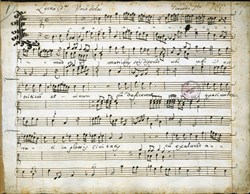The musical scene of Spanish Naples

From a cultural point of view, the Spanish rule in Naples was often considered as a reason of decline, but recently the role of Naples in those years has been re-evaluated as a prelude to the following full affirmation of the Neapolitan Music School, a definition with which scholars have remarked the fervor and the unique character of the Neapolitan artistic development between the sixteenth and eighteenth century. The uniqueness of Naples lies mainly in the mixture of aristocratic and popular culture that has generated in these three centuries unexpected and inimitable developments in the reworking of pre-existing musical forms and styles. The education of the young neapolitan aristocrats was based on the study of music and on the publication of treaties and music anthologies: we can consider the examples of Carlo Gesualdo, Prince of Venosa, Fabrizio Dentice lute virtuoso and composer of polyphonic music, the Prince of Salerno Ferrante Sanseverino, who in the first half of the sixteenth century dominated the cultural life in Naples, coming to turn his palace (now Church del Gesù Nuovo) in an auditorium for concerts and academies. The activity of the Royal Chapel, in the moment of transition from the Aragonese domination to the Spanish government continued to be alive, indeed increased its work thanks to the coming of musicians from Spain and Northern Europe, first of all Giovanni de Macque. He became organist at the Viceroyal Chapel since 1594 and choirmaster from 1599 until his death in 1614. He was the teacher of a great generation of Neapolitan musicians among them the name of Giovanni Maria Trabaci is pre-eminent.
It was fundamental the already mentioned feature of the Neapolitan musical culture to produce sacred and secular music, classical and popular, making communicate by osmosis parts and forms of both, without creating separate or too defined areas. In this context a great importance was given to the cult of San Gennaro, who was alive throughout the city, but especially at the Chapel of the Treasury, and to many sacred ceremonies in some Neapolitan churches, inspired by musicians trained in the four conservatories or in many orphanages, which favoured the composition of sumptuous melodies for two or four choruses. The main sacred musical realities of Naples in the sixteenth and seventeenth centuries were represented by the Royal Chapel and the Chapel of the Treasure of San Gennaro – opened in 1646 – both surrounded by charitable institutions designed to uplift the lives of many disadvantaged poor. Among the first and most well-known initiatives, we remind the House of the Santissima Annunziata, an institution devoted to the care of abandoned and sponsored by the aristocracy of Naples. It was founded in 1318 and lasted for a very long, reaching up to the middle of the twentieth century and offering its assistance in particular to the abandoned girls, to which was ensured an education enriched by music with the creation of a stable musical Chapel.
